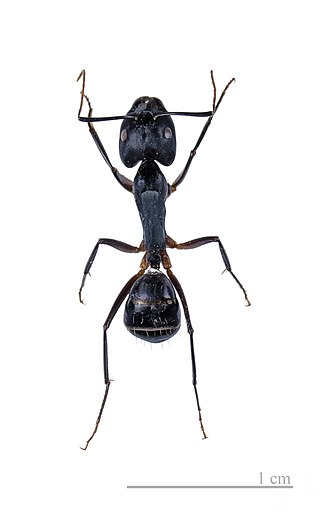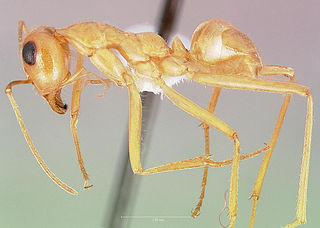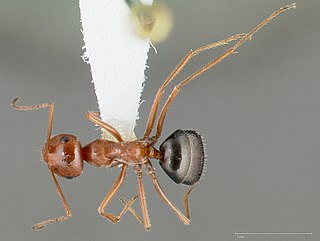
Ants are eusocial insects of the family Formicidae and, along with the related wasps and bees, belong to the order Hymenoptera. Ants evolved from vespoid wasp ancestors in the Cretaceous period. More than 13,800 of an estimated total of 22,000 species have been classified. They are easily identified by their geniculate (elbowed) antennae and the distinctive node-like structure that forms their slender waists.

Honeypot ants, also called honey ants, are ants which have specialized workers that consume large amounts of food to the point that their abdomens swell enormously. Other ants then extract nourishment from them, through the process of trophallaxis. They function as living larders. Honeypot ants belong to any of several genera, including Myrmecocystus and Camponotus. They were first documented in 1881 by Henry C. McCook, and described further in 1908 by William Morton Wheeler.

The Formicinae are a subfamily within the Formicidae containing ants of moderate evolutionary development.

Lycaenidae is the second-largest family of butterflies, with over 6,000 species worldwide, whose members are also called gossamer-winged butterflies. They constitute about 30% of the known butterfly species.

Myrmecia is a genus of ants first established by Danish zoologist Johan Christian Fabricius in 1804. The genus is a member of the subfamily Myrmeciinae of the family Formicidae. Myrmecia is a large genus of ants, comprising at least 93 species that are found throughout Australia and its coastal islands, while a single species is only known from New Caledonia. One species has been introduced out of its natural distribution and was found in New Zealand in 1940, but the ant was last seen in 1981. These ants are commonly known as bull ants, bulldog ants or jack jumper ants, and are also associated with many other common names. They are characterized by their extreme aggressiveness, ferocity, and painful stings. Some species are known for the jumping behavior they exhibit when agitated.

Iridomyrmex is a genus of ants called rainbow ants first described by Austrian entomologist Gustav Mayr in 1862. He placed the genus in the subfamily Dolichoderinae of the family Formicidae. It has 79 described species and five fossil species. Most of these ants are native to Australia; others are found in Asia and Oceania, and they have been introduced to Brazil, New Zealand, and the United Arab Emirates. Fossil species are known from China, France, and the United States.

Monomorium is a genus of ants in the subfamily Myrmicinae. As of 2013 it contains about 396 species. It is distributed around the world, with many species native to the Old World tropics. It is considered to be "one of the more important groups of ants," considering its widespread distribution, its diversity, and its variety of morphological and biological characteristics. It also includes several familiar pest species, such as the pharaoh ant and the flower ant.
Roy R. Snelling was an internationally renowned American entomologist who studied Hymenoptera, mainly ants, wasps and bees. He was the emeritus collections manager at the Natural History Museum of Los Angeles County where he worked for over 30 years, joining the museum in 1963 and retiring in 1993. He dedicated his professional life to making insect biodiversity better known and appreciated.

Myrmecocystus, is a North American genus of ants in the subfamily Formicinae. It is one of five genera that includes honeypot ants. Worker ants keep and tend plerergates, which are other ants that store large quantities of nutritious fluid in their abdomens to feed the colony during famine times. Some species engage in highly territorial tournaments, which can result in intraspecific slavery. During the raids, they carry off larvae, workers, and plerergates. The genus has three subgenera, namely Myrmecocystus, Endiodioctes, and Eremnocystus.

Myrmecocystus mexicanus is a species of ant in the genus Myrmecocystus, which is one of the six genera that bear the common name "honey ant" or "honeypot ant", due to curious behavior where some of the workers will swell with liquid food until they become immobile and hang from the ceilings of nest chambers, acting as living food storage for the colony. Honey ants are found in North America, Australia, and Africa. Ant species belonging to the genus Myrmecocystus reside in North America. M. mexicanus in particular is found in the southwestern United States and parts of Mexico.

Dorymyrmex bicolor is a species of ant in the Dolichoderinae subfamily, known as bicolored pyramid ant due to the two-toned body color and the shape of their mounds. Dorymyrmex bicolor was recently known as Conomyrma bicolor but has been renamed to Dorymyrmex bicolor.It has a single petiole and a slit-like orifice which releases chemical compounds. This ant does not have the capability to sting. It is primarily found in arid desert regions in Central and South America and the southwestern United States.

Myrmecocystus wheeleri is a species of honeypot ant native to California, Baja California, and Coahuila.

Myrmecocystus placodops is a species of honeypot ant native to the southwestern United States and northern Mexico.

Myrmecocystus kennedyi is a species of honeypot ant in the subgenus Endiodioctes native to the western United States and western Mexico.

Myrmecocystus mendax is a species of honeypot ant native to Mexico and Southwestern United States.

Myrmecocystus semirufus is a species of honeypot ant native to the western United States, Baja California, and Sonora.

Myrmecocystus yuma is a species of honeypot ant native to the southwestern United States and a small part of Northern Mexico. This species, like most in the genus Myrmecocystus, create worker repletes.

Myrmecocystus flaviceps is a species of honeypot ant in the subgenus Endiodioctes native to the western United States, western Mexico, and Hidalgo.
















